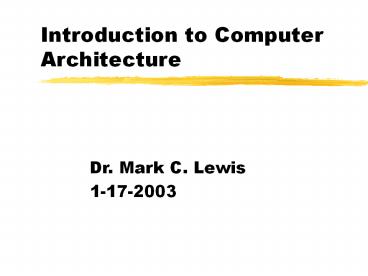Introduction to Computer Architecture - PowerPoint PPT Presentation
Title:
Introduction to Computer Architecture
Description:
Introduction to Computer Architecture Dr. Mark C. Lewis 1-17-2003 – PowerPoint PPT presentation
Number of Views:536
Avg rating:3.0/5.0
Title: Introduction to Computer Architecture
1
Introduction to Computer Architecture
- Dr. Mark C. Lewis
- 1-17-2003
2
Opening Discussion
- At the beginning of every class we will do a
brief discussion of some questions I provide and
any questions you might have. Typically mine
cover the previous lecture and the reading for
the current one. - There was no previous one so Im interested in
just getting to know a little about each of you
and your background. Also, what do you know
about Java/OOP?
3
Basic Information
- Try to log onto the machines and bring up a
browser. - Course web page http//www.cs.trinity.edu/mlewis
/CSCI2321-S03 - Office HAS 201K
- Phone 999-7022
- e-mail mlewis_at_trinity.edu
- Office hours 300-500 M, 930-1100 W,
230-530 R or by appointment
4
Text and References
- Computer Organization and Design by Patterson
and Hennessy. This is a very good book and unless
you decide you want to persue hardware design
significantly further it is probably all you will
need. They do have a more advanced text if it
interests you. - Web sites are good supplemental reading to keep
you up on what is happening today. Se the Links
page.
5
Course Description
- This course is intended to give you knowledge of
what happens in a computer at a lower level than
the programming languages you typically use.
This includes two main components
machine/assembly language and computer
architecture/hardware. - In particular we will be looking the the MIPS
processor and the low level languages for it.
6
Assignments and XSPIM
- Your assignments are basically going to come from
the textbook. Some of them will involve
programming at the assembly level. As mentioned,
this will be done with MIPS assembly. We do have
some MIPS machines in the department (the SGIs in
200), but Im not certainly you can get on them.
It will generally be easier and nicer to use
xspim on these machines. It is a MIPS emulator.
7
Grades
- Your grade in this class is determined by a
combination of 4 parts.
8
Lectures/Schedule
- The web page also has a schedule for the entire
semester. It includes not only the topics, but
also readings and due dates for everything that
receives a grade. - On this page I will also provide links to the
notes I put on in PDF format. I do this at least
the night before class. I do this because you
should never feel like you have to write down
what is on the slides. Focus on listening so you
can grok the material and take notes on
interesting points not in the slide text.
9
Think More - Work Less
- For those of you who dont know this yet, my
overriding objective in this class is to get you
to think. During the course of the semester
several lights should come on in your head as
different ideas start to make sense. - Unlike the intro sequence courses, there isnt
that much coding in here. Those lights will
probably come on when you are just thinking, not
typing.
10
Complex Yet Simple
- Computers are some of the more complex devices
ever created by humans, yet in many ways they are
quite simple. The part of a computer that does
most of the work, the CPU, is build of pieces
that all nearly identical transistors etched
into silicon. It just happens to be built from a
very large number of them. (100 million for the
newest generation of chips).
11
From C to Execution
- So how does the code that you type in go from
text to executing on the computer processor doing
your bidding? - You know a bit about the first step, compiling,
where the program is translated to a different
form that the computer understands. We will look
more at the language it gets translated to. - The question then becomes, how does a piece of
silicon turn the instructions of that language
into a dynamic computation?
12
Elementary my dear Watson
- To carry out your instructions, the computer uses
one thing logic. A processor is basically a
device that can perform logic on electronic
signals. - Our job this semester is to see how this is done
and to give you some vague idea of how a computer
can be built to do computations.
13
Warning!!!
- As with all people, I have biases. In the area
of microprocessors, my bias is typically against
Intel. I will try not to let that cloud what I
teach and you shouldnt let it cloud what you
learn.
14
Minute Essay
- At the end of every class I will have you write
me a minute essay. This is a few sentences
that shouldnt take you much more than a minute.
I will typically ask some type of question for
you to answer. You can also provide any form of
feedback on anything from the class you want to.
Make sure your names are always on these as I use
them for attendance and feedback. - What are your thoughts on the class description?
What do you want to get from this course?






























